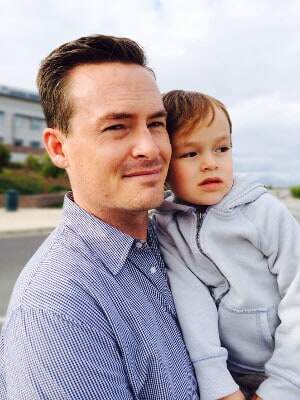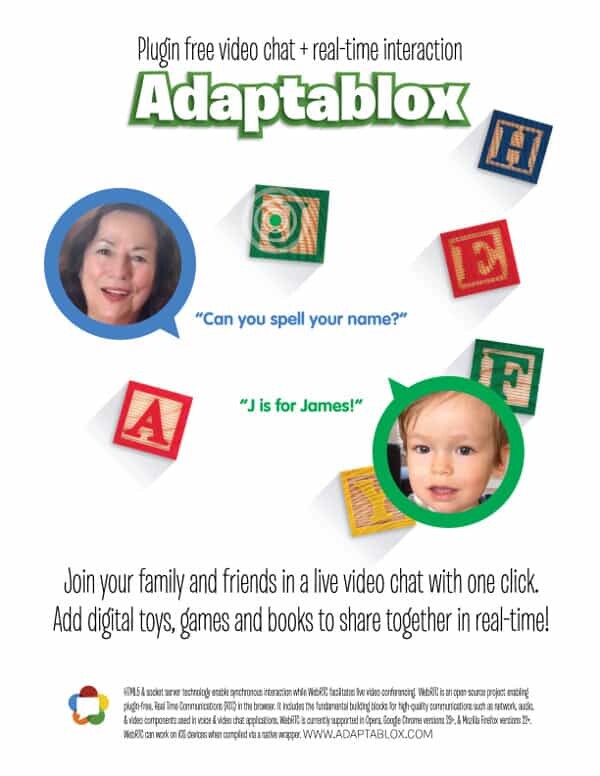Gaming? Social? Video calling? Adaptablox has it all in a very interesting package.
This whole notion of WebRTC-for-gaming is quite frustrating. There’s very little of it still.
 When Bart Yeary, Chief Product Officer of Resonant Games introduced me to Adapatablox, I was immediately fascinated. To me, Adaptablox looks like a free-form game to play with kids online and remotely. My only gripe is that the letters on the blox aren’t in Hebrew.
When Bart Yeary, Chief Product Officer of Resonant Games introduced me to Adapatablox, I was immediately fascinated. To me, Adaptablox looks like a free-form game to play with kids online and remotely. My only gripe is that the letters on the blox aren’t in Hebrew.
Anyway, Bart was kind enough to share his experience and views regarding the use he made of WebRTC for Adaptablox.
What is Adaptablox all about?
The Adaptablox concept was born out of a need to create a better video chat experience for kids and their distant relatives. We provide a solution to meet the needs of distributed families with young children by adding context to their long distance conversations. Family members join an Adaptablox video chat via a unique web address and instantly begin to share interactive content in real-time. Each participant shows up as a video inside of a circle with a pointer to indicate their cursor position. They can see each other’s movements and synchronously interact with content like educational games, toys and books. Currently the site provides a set of ABC blocks that can be dragged & dropped to collaboratively spell words but ultimately the app will host a series of puzzles, interactive books and learning games.

Where did the idea come from?
My studio, Resonant Games, has been developing synchronous social games and virtual worlds for the past 15 years. Back in 1999 we launched the first browser based virtual world at Faketown.com. We specialize in building lightweight, highly accessible yet immersing experiences that enable people to interact and share content in real-time. When I became a dad I worried because our son’s nearest relatives were over 500 miles away and I wanted his grandparents to share in his early development. I began thinking of ways that we could leverage real-time technology to bring our family closer together with more meaningful shared experiences. Clearly, video chat is more rewarding than a phone call but the average grandparent doesn’t have the confidence to download and configure an application. Moreover, many young kids lack the patience to stay focused during a video call and as a result they get distracted instead of focusing on the conversation. When we discovered WebRTC we realized that we could create an instant video chat layer on top of our synchronous content to create an immersing yet accessible app specifically for distributed families with young children.
You started from the desktop. When will we see a mobile version?
Adaptablox is being built with an emphasis on accessibility. It is our goal to enable families to safely connect in a shared virtual space without any friction or specific hardware requirements. As such we intend to continue developing the core of our product for the browser while iterating on a native mobile/tablet extension that is interoperable with that experience.
Why use WebRTC for such a service?
WebRTC enables plugin free video chat that is much more accessible than downloadable solutions. Statistics show that 75% of grandparents are comfortable browsing the web (US Census Bureau 2014, American Community Survey) but only 12% are using Skype. Nonetheless, 11% of grandparents say that Skype is their preferred method of staying in touch with their grandkids (MetLife: Grandparents Investing in Grandchildren). Because we can embed WebRTC video chat directly on top of synchronously interactive content we can merge video conversations with shared books, toys and educational games without the need for a plugin.
What excites you about working in WebRTC?
WebRTC brings the magic of video chat and synchronous play to less technically savvy grandparents and kids. It allows us to keep the focus on a seamless shared experience rather than forcing the end user through a frustrating on-boarding process or software configuration. WebRTC also enables us to develop for both web and mobile apps so that our virtual family HUB is accessible across all devices and platforms.
What signaling have you decided to integrate on top of WebRTC?
We’ve been very happy with the realtime syncing service provided by Firebase.
Backend. What technologies and architecture are you using there?
We built our backend in Ruby on Rails, and currently host it at Heroku. Adaptablox will eventually be a platform that artists and developers can build upon, so we’ve designed the architecture around RESTful principles which will be easy to generalize into an API when the time comes.
Where do you see WebRTC going in 2-5 years?
We are hopeful that all major browsers will incorporate support for WebRTC. We believe that synchronous applications will become much easier to develop in the coming years and as a result the refinement of the user experience and the content provided in a real-time context will be the main differentiators.
If you had one piece of advice for those thinking of adopting WebRTC, what would it be?
When developing your MVP it makes sense to leverage services like TokBox to experiment with WebRTC. In general, we believe that the path of least resistance is the best approach to building new products. If we believed that OpenTok couldn’t provide the stability or features that we needed we might consider another solution but so far we have been pleased with their service.
What’s next for Adaptablox?
We intend to offer vanity URL’s for easier sharing and password protection for more secure family spaces. Our team is currently creating a framework for developing educational games that we will ultimately open up to 3rd party studios and we also have a series of interactive books that we are designing internally. Finally, we intend to deploy a subscription service to provide access to premium content that can be shared during Adaptablox video calls.

I was a huge fan of FakeTown back in the day in its early version and 2.0 version. Now an early version of 3.0 is out and I’m looking forward to seeing where it goes next (if anywhere). Not sure if the other projects are taking up all the time or not.
Nonetheless, good to see you’re still at it Bart and haven’t abandoned what you enjoy doing. Good luck!